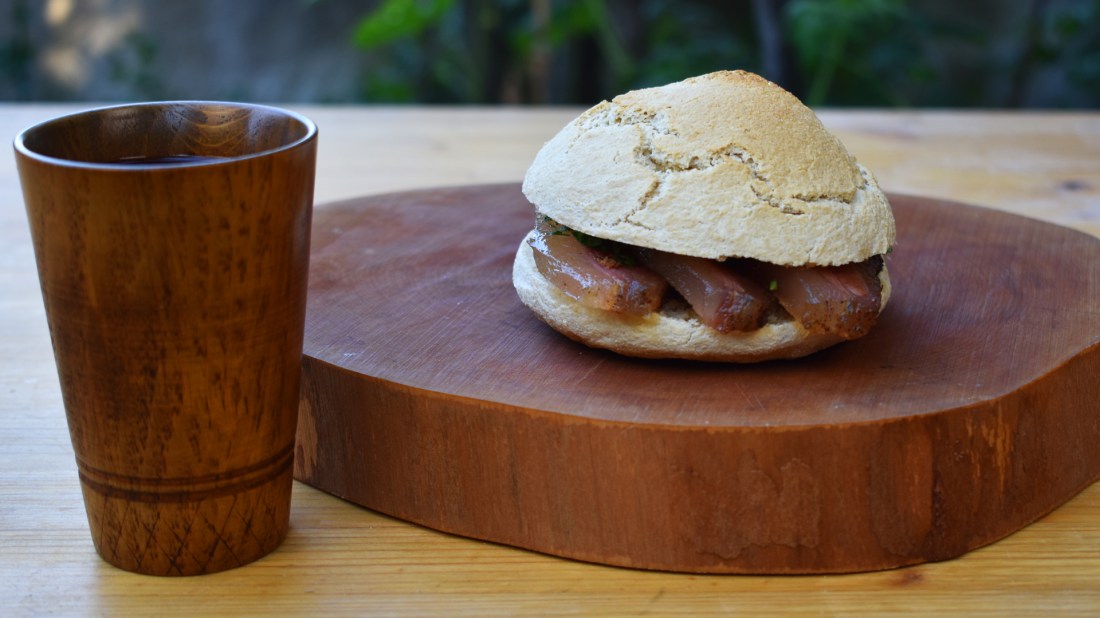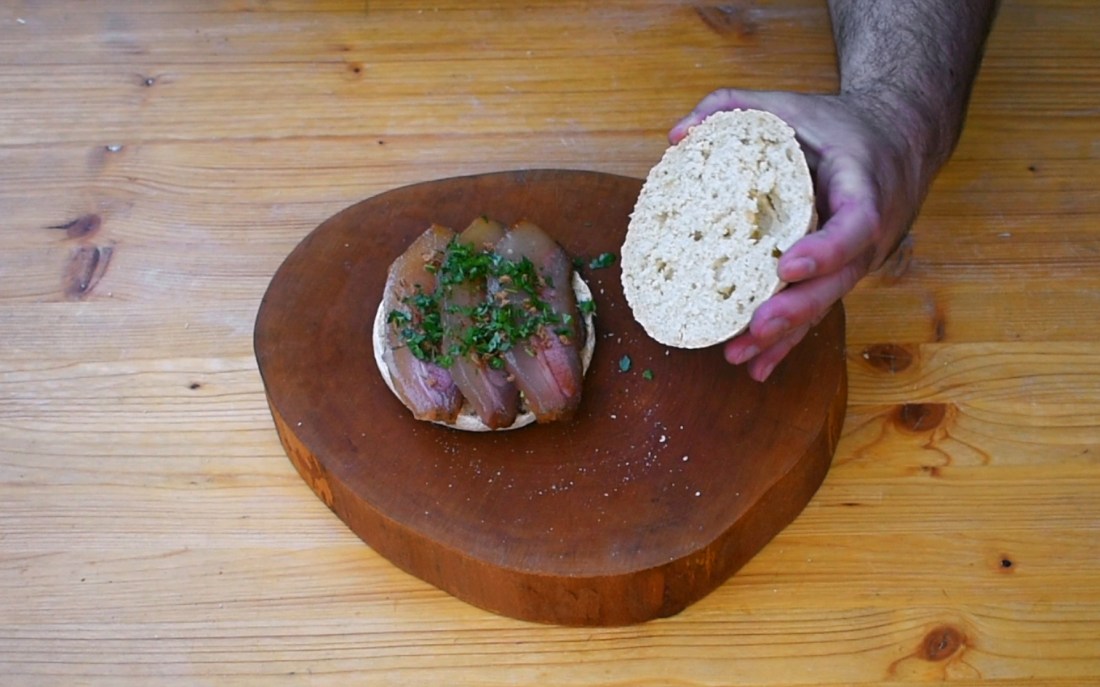Literary medieval sources contain sometimes interesting information about food and daily life. We used poetry sources in the past to recreate a farmer’s meal and Horace’s dinner. Clearly, it is important not to take them literally, in particular, if the intent of the author is amusing the reader with absurd situations, as Boccaccio does in his Decameron. Anyway, they are important to understand better the way people lived in the past without the oversimplification that sometimes comes from school memories and to remember that the medieval world was more complex than we sometimes think.
This week we are preparing a breakfast described in a 14th-century book of tales, called Trecentonovelle, written by Franco Sacchetti, in which the author treats food and dinners frequently. Here you find the original Italian version of the tale.
The story tells about Testa (head in Italian) di Todi, a provost lived under Pope Urban V (who was elected in 1362) who habitually began his day drinking wine. One day, to prevent wine from giving him some annoyance and clearly to drink more, he takes a slice of salted meat and a loaf of bread and goes to his kitchen, then roasts the meat on charcoals for a while. As soon as the meat is warmed, he is summoned by Guglielmo, a deputy for the pope. Testa, who does not want to waste his arrosticciana or carbonata, stuffs the bread with this meat and squeezes the sandwich in his pocket. But Guglielmo has a dog who smells the meat and continues to move around him, sniffing his pocket insistently, placing his muzzle under Testa’s cloak, and howling. Testa, not able to take anymore, toss the sandwich to the dog saying him to have it in the name of the Devil. So, Messer Guglielmo praises him for his love for the church: Testa is not kind to him or the pope himself, instead, he offered such a nice breakfast to his humble mutt (in the text, it is used a pejorative and belittling form: vile cagnucciuolo).
Clearly, drinking wine at breakfast is not common and the author blames this habit, associated with a laughable character. His intent is satire and irony, yet, drinking a small quantity of wine at breakfast is not an idea foreign to medieval medical advice. In the Regimen Sanitatis Salernitanum (11th century), indeed, we find the curious suggestion to drink wine in the morning as a medicine in case, taken in the evening, it causes harm.
In this case, the food is just a way to help our Testa to drink more, and it has nothing to do with healthy habits. The characteristic of salted meat as a stimulant for thirst is mentioned also by Platina in his De Honesta Voluptate et Valetudine, written in the 15th century, one of the sources we are using to prepare the carbonata described in the tale alongside with Maestro Martino’s Libro De Arte Coquinaria, dating back to the same period. Maestro Martino too suggests drinking while eating it.
We paired this very simple dish with a millet bread described in many medical handbooks, in particular the book about foods by Michele Savonarola (14th century). Below, you find the original recipe of carbonata by Maestro Martino with our translation, a few notes about millet bread, and the video of the recipe with subtitles in English and Italian.
If you want to know more about historical pasta, read our book Early Italian Recipes. Cereals, bread, pasta, and pies, where you will find historical information about cereals and their preparations from the Antiquity to the end of the Renaissance, with 114 recipes for pasta, bread, pizza, pies, and more, newly translated and explained.
If you are interested in late-medieval cuisine, we recommend Libro de la Cocina. Medieval Tuscan Recipes and Registrum Coquine. A medieval cookbook. To learn about the transition between ancient and medieval cooking, check out De Observatione Ciborum, written by the physician Anthimus to the king of the Franks Theuderic. If you are interested in recipes for vegetables from the Antiquity to the beginning of the Modern Era in Early Italian Recipes. Vegetables, fruit, herbs, and flowers available in English and Italian.
For information about ancient cuisine, read Ancient Roman Cooking. Ingredients, Recipes, Sources. Moreover, full translations of historical sources and articles on ancient and medieval cooking are available on Patreon.
To support our work, you can buy us a beer or purchase our merchandise.
CARBONATA
Ingredients
guanciale or pancetta
brown cane sugar
cinnamon
parsley
vinegar
Method
Slice the guanciale and mince a few leaves of parsley. Grind sugar and cinnamon in the mortar. Cook for a short time the sliced meat with a bit of vinegar on charcoals or in a pan, then plate stuff a millet bread, dusting with cinnamon and sugar, and adding the minced parsley on the top.
Original text
Togli la carne salata che [sia] vergellata di grasso et magro inseme, et tagliala in fette, et ponile accocere ne la padella et non le lassare troppo cocere. Dapoi mittele in un piattello et gettavi sopra un pocho di zuccharo, un pocha di cannella, et un pocho di petrosello tagliato menuto. Et similemente poi fare de summata o presutto, giongendoli in scambio d’aceto del sucho d’aranci, o limoni, quel che più ti piacesse, et farratte meglio bevere.
Translation
Take salted meat with lean and fat parts and slice it. Cook the meat in a pan for a short time. Then, plate it sprinkling sugar, cinnamon, and a bit of minced parsley. You may prepare in a similar way summata [cured pork breast, a kind of historical cured meat no more produced in Italy] or ham, adding orange or lemon juice instead of vinegar, the one you prefer, and it will be better to drink.
MILLET BREAD
Ingredients
500 gr white wheat flour
500 gr millet flour
sourdough
salt
Method
Knead the wheat and millet flour with sourdough, a couple of pinches of salt, and warm water until you reach a smooth consistency. Let the dough rest overnight.
Shape three loaves and let them rest for a while, then bake them in the oven for about half an hour. It is better to eat millet bread still hot, as suggested by Columella and other authors.
Note about millet bread
Panis miliaceum is among the kinds of bread described by Pliny in the 1st century and appears in the medical medieval books as well as in the pictures of the various Tacuina Sanitatis. As for the most part of basic methods, there is not a precise recipe, given for granted. However, throughout the centuries, the method continues to be the same described by Cato in his De Agri Cultura, with the directions provided by Galen in his De Facultatibus Alimentorum: a temperate bread is well-kneaded, salted, and leavened, cooked for a long time at low heat, not excessively big nor too little. We reduced the size to adapt it for the carbonata recipe. Despite his work was not known directly by the medieval Italian authors, Galen’s medicine is fundamental in all the Middle Ages thanks to the influence of Byzantine and Arabic books.
Michele Savonarola writes that millet is scarcely nutritious, hard to digest, and produces scant blood. If someone wants to lose weight and has a strong stomach, should eat millet bread. Bread made with half millet and half wheat flour (the author always means white wheat flour, considered the best quality), instead, provides good nourishment. The ratio between the cereals may change depending on the complexion.
For this recipe, we used sourdough, considered the best leavener for bread. We wrote more about it in this article.
Buy me a coffee
Patreon
Medieval Tuscan Recipes Playlist
Ancient Roman Recipes Playlist
Ancient Greek Recipes Playlist
Medieval Recipes Playlist
YouTube Channel
Merchandise
Books
Early Italian Recipes. Cereals, bread, pasta, and pies
Libro de la Cocina by Anonimo Toscano. Medieval Tuscan Recipes
Early Italian Recipes. Vegetables, fruit, herbs, and flowers
De Observatione Ciborum by Anthimus. Early-medieval recipes at the court of the Franks.
Registrum Coquine by Johannes Bockenheim. A medieval cookbook
Ancient Roman Cooking. Ingredients, Sources, Recipes
Translations of Historical Sources
De Agri Cultura by Cato – first part (2nd century BCE)
De Re Coquinaria by Apicius (Ancient Rome)
Apicii Excerpta by Vinidarius (5th or 6th century)
De Observatione Ciborum by Anthimus (6th century)
Appendicula de Condituris Variis by Johannes Damascenus (8th or 9th century)
De Flore Dietarum (11th century)
Tractatus de Modo Preparandi et Condiendi Omnia Cibaria (13th or 14th century)
Liber de Coquina – first part (14th century)
Enseignemenz (14th century)
Opusculum de Saporibus by Mainus de Maineris (14th century)
Libro de la Cocina by Anonimo Toscano (14th century)
Anonimo Veneziano (14th century)
Registrum Coquine by Johannes von Bockenheim (15th century)
Libro de Arte Coquinaria by Maestro Martino – parts 1-4 (15th century)
Recipes
Tuscan Chicken Soup with Unripe Grapes
Early-medieval Kohlrabi Stew
Tuscan Fried Leek Rings
Pork Ribs
Tuscan Pancakes with Wild Flowers
Hop Shoots
Shrimp – Savore de Gambari
Orange Frittata – Fritata de Pomerantiis
Tuscan Soup with Hen and Florence Fennel
The diet of the Franks – Celery Root and Beef Stew
Tuscan Fish Cakes – Salciccie di Pescio
Tuscan Stew with Pork Belly and Rutabaga
Pork and Onion Soup
Tuscan Radish Soup
The Diet of the Franks – Endive and Pork Jowl
Tuscan Fried Meatballs
The Diet of the Franks – Chicken Stew
Castagnazzi
Renaissance Stuffed Cucumbers
Pork Roast with Cherry Sauce
Renaissance Fried Tomatoes
Herbolata
The Diet of the Franks – Beef Stew
Fried Chicken Soup
Beef Roast with Garlic Sauce
Bread Soup
Salted Meat and Peas
Baghdadi Rice Cream
Chicken with White-Pepper Sauce – Piperatum Album
Indian Chickpeas and Meat
The Diet of the Franks – Pork Stew
Chestnut and Mushrooms
Lentils with Oregano and Watermint
Egyptian Bread with Pistachios and Almonds
Veal with Fennel-Flower Sauce
Pork Roast with Green Sauce
Eggs Poached in Wine
Brodium Theutonicum
Crispellae – Pancakes with Saffron and Honey
Brodium Sarracenium – Chicken Stew
Fava Beans and Pork
Erbe Minute – Meatballs with Herbs
Lettuce and Pork Soup
Zanzarelli – Egg and Cheese Soup
Turnip and Beef Soup for Servants
Cheese Pasta – Vivanda Bona
Gratonata – Chicken Stew
Chickpea Soup with Poached Eggs
Apple Fritters
Hippocras and Claretum – Mulled Wine
Pastero – Pork Pie
10th-century Goat Roast – A Langobard at the Court of the Byzantine Emperor
Romania – A Recipe Between Arabic and Italian Tradition – Medieval Chicken with Pomegranates
Emperor’s Fritters
Medieval Pizza – The Origin of Pizza
Roast Chicken with Salsa Camellina
Sweet Rice
Afrutum or Spumeum – 6th-century Byzantine recipe
A Medieval Breakfast – Wine, Carbonata, and Millet Bread
Salviata – Eggs and Sage
Tria di Vermicelli
Cabbage Soup
Frittelle Ubaldine – Pancakes with Flowers and Herbs
Saffron Cheesecake
Drunken Pork – Early Medieval Pork Stew
Medieval Monk’s Stuffed-Egg Soup
Apple Pie
Onion Soup
Gnocchi
Lentils and Mustard Greens
Chicken soup – Brodo Granato
Turnip Soup
Beans and Bacon – Black-Eyed Peas
Prawn Pie – Pastello de Gambari
Foxtail Millet Polenta and Spit-Roasted Goose
Beef Stew
Blancmange
Leek Soup
Quail Stew with Coconut
Chicken Pie
Ravioli
Almond Cream
Red Mullet Soup
Spit Roast Beef with Arugula Seeds
Walnut Bread
Lasagna
Tripe
Fried Fish
Roast Lamb with Green Sauce
Clams
Sweet and Sour Sardines
Trouts with Green Sauce
Lamb Stew
Quails with Sumac
Chicken with Fennel Flowers
Sea Bream


